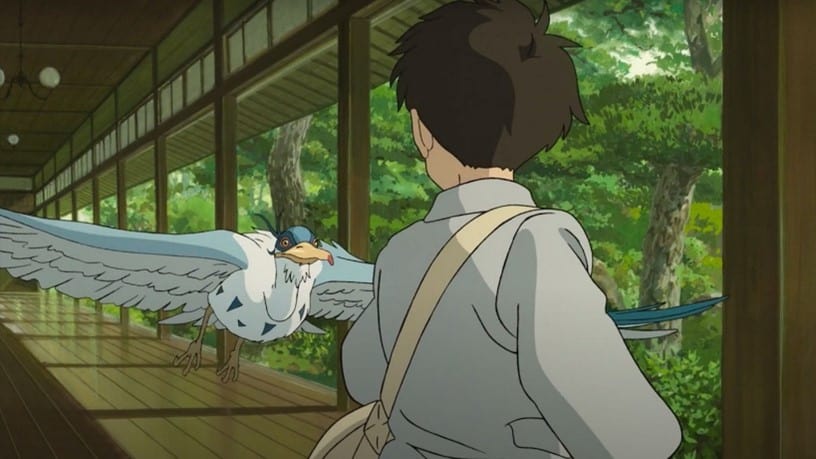By Andrew Jenck
The work of Hayao Miyazaki is iconic to the point where one has seen something inspired by him even without watching any of his films. After a decade hiatus, The Boy and the Heron sees the return of the acclaimed anime director, one that may be off-putting to newcomers, given the narrative structure. Although its main theme is made clear, the storytelling could be confusing for those more accustomed to typical American scripts. However, moviegoers only need to be swept up in the adventure to appreciate Miyazaki’s direction, as he delivers a well-detailed, nuanced picture that will leave viewers still thinking of it days later. Uneven edges aside, The Boy and the Heron is solid to its core, an immersive experience where further thought and a repeat viewing reveal great craftwork and a narrative of finding harmony in such unsettling times.
Set in wartime Japan, a boy named Mahito grieves over the loss of his mother while his father marries his late wife’s sister (it was the 40s). Emotionally cut off, he’s lured in by a humanoid heron to a world connected to a distant relative and has apparently captured his new parent, Natsuko. Evoking the sense of Alice in Wonderland, or an “isekai” in anime terms, Miyazaki employs his signature immersion through emphasis on nature inhabited by unusual creatures. Hayao always has had an appreciation of naturalistic beauty and translates this through fluid animation. There’s a sense of realism, particularly how wind breezes through grass or how waves flow but with extra detail that would go unseen in real life. Character animation is different for everyone, each having their own form of walking emphasizing their personality; whether stiff like the grief stricken Mahito or the slow walk of the mother under pressure. The heron will walk and fly like a real bird even when transforming into his more humanlike appearance, a good blend of the fantastical and realism.
Such animation will lure audiences in even if they find the narrative unusual, even for some longtime fans. The first act is a slow burn, establishing character traits and relations while hinting at secrecy. Some of the buildup could’ve been briskier, yet there’s some quirky comedy and magical intrigue to keep attention. One should focus on the general feeling of each scene rather than its logical workings, the latter of which will come upon reflection. Through the aforementioned character animation, developments happen through deliberate posing and interactions. Mahito may appear isolated at first, but gradually displays more emotions through the adventure, leading to scenes with strong resonance. Some characters could’ve been developed more, but the voice actors work well with the animators to give them full life. Miyazaki is calling the audience to be swept away in the adventure, yet also to be observant.
The title is a bit misleading, as the heron is less vital as it would imply, being an initiator and somewhat of a minor character. It gives the false sense that he is a co-lead and could potentially confuse audiences. The original Japanese title, How do you Live? is more fitting to the film’s central theme: having to embrace negativity in life while also finding balance. Throughout the adventure, there’s an imbalance of wonder and danger, as if it was created to not be the real world rather than a functioning world of its own. Natsuko feeling unappreciated by Mahito, while about to give birth to a child is one of the many personifications of this imbalance. Every scene emphasizes this theme continually, ranging from nuanced facial animations to general world-building. Comprehending these elements is the score by Joe Hisashi. Having composed all the auteur’s films, he understands Miyazaki’s intentions to a tee. One may not fully understand the setting but will get the feel of it from his striking notes and melancholy themes.
The Boy and the Heron makes for one of the most layered and thoughtful pictures of 2023, as Hayao Miyazaki utilizes his emphasis on nature once again for an interpersonal journey, finding balance among inner turmoil. Whereas many films spoon-feed their audience regarding world-building, it’s refreshing to see a film focused more on the experience and impact. To anyone unfamiliar with Miyazaki going in, focus less on what you should understand and more on how you feel. Afterall, it is a film that asks not, “How do you think?” but “How do you live?”


